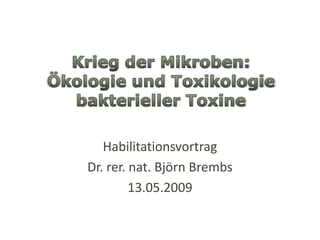
Microbe wars: the ecology and toxicology of bacterial toxins
- 1. Habilitationsvortrag Dr. rer. nat. Björn Brembs 13.05.2009
- 2. Wirkungsgefüge von Lebensgemeinschaft (Biozönose) und Lebensraum (Biotop)
- 3. • Offen, dynamisch, komplex • Trophische Ebenen – Produzenten – Konsumenten – Destruenten • Sukzession – Mosaikbildung • Konkurrenz, Predation, Mutualismus, Kommen salismus
- 4. • 1014 menschliche Zellen • 1015 Bakterien • 1017 Viren • Mikrobielles Metagenom evtl. grösser als menschliches Genom • 98% Sequenzidentität zw. Mensch und Schimpanse, jedoch nur 50% mikrobielle Speziesidentität
- 5. Mims C et al. Medical Microbiology, 2004.
- 6. • Streptococcus gordonii vergärt Kohlenhydrate zu Milchsäure • Veilonella atypica nutzt Milchsäure als Energielieferant • V. atypica induziert Amylase-Aktivität in S. gordonii Egland P. G. et.al. PNAS 2004;101:16917-16922 ©2004 by National Academy of Sciences
- 7. • Erste Welle (Gram+) Streptokokken binden Oberflächenproteine • Zweite Welle (Gram-) Brückenspezies F. nuclearum bindet andere Bakterien • Dritte Welle: Biofilm Kolenbrander et al. 2002, Microbiol Mol Biol Rev 66:486
- 8. Biofilme http://www.socialfiction.org/img/biofilm.jpg
- 10. • Buchnera aphidicola: Gram negative, intrazelluläre Bakterien in spezialisierten Bakteriozyten • Stellt dem Wirt kritische Nährstoffe zur Verfügung • Seit mehr als 150 Mio Jahren vertikal übertagen (Mutter-Nachkommen) • Mit E. coli verwandt, Genom drastisch reduziert (600 von ~4000 urspr. Genen)
- 11. Maternale Bakteriozyten Späte Embryonen mit Symbionten Frühe Embryonen mit sichtbaren Symbionten 1 mm J. Sandström
- 12. Blattlaus-Eier mit Buchnera der Mutter 0.5 mm A. Mira
- 13. • Streptococcus sobrinus Rasen • Streptococcus mutans Kolonien • Mutazin I und IV Photo: Dr. Jens Kreth
- 14. • Von den meisten Bakterien produzierte Peptide • Meist nur für nah verwandte Arten bakteriostatisch oder bakterizid wirkend • Ohne Resistenzmechanismen sind auch die produzierenden Zellen betroffen Stamm Bakteriozin Wirkspektrum Lokalisierung Lactobacillus Lactobacillus sp Lactacin F Plasmid Enterococcus acidophilus feacalis Lactobacillus Sakacin P Lactobacillus sp nicht bekannt Carnobacterium sp sake Sakacin A Plasmid Lactobacillus sp Enterococcus sp Listeria monocytogenes Lactobacillus Lactobacillus sp Curvacin A Plasmid Listeria curvatus monocytogenes
- 15. a) Porenbildung – Häufigster Mechanismus – Membran Depolarization – Elektrolyt-Verlust – Letztendlich Lyse b) Zellwand-Degradation – Löst Peptidoglycane auf – Lyse c) Nuklease Aktivität – Chromosomale DNA – 16S-RNA Cursino et al. 2002. Brazilian Journal of Microbiology 33: 185-195
- 17. Gram-positive, fakultativ anaerobe Kokken: • Kommensales Hautbakterium • Staphylokokken-Enterotoxine • Toxic shock syndrome Toxin (TSST)
- 19. Gram-negatives Stäbchen: Cholera Toxin
- 24. Aufnahme durch die Haut
- 25. Gram-negative Stäbchen • Bakteriozine • Immunsuppressiv • Yersinia outer proteins (Yop)
- 27. • Typ I Toxine: Rezeptorbindend – Binden an die Zelloberfläche werden aber nicht in die Zelle transloziert (SEB) • Typ II Toxine: Porenformend – Formen Poren in der Zellmembran (Anthraxtoxin PA) • Typ III Toxine: Intrazellulär wirkend – Rezeptor-gekoppelte Translokation in die Zelle und Schädigung intrazellulärer Komponenten (Botulinumtoxin)
- 28. Typ I Typ II Typ III
- 29. • Zell Lyse (Hämolysine, Leukozidine) • cAMP Anstieg (Cholera Toxin) • Blockade der Proteinsynthese (Diphtherie Toxin) • Hemmung der synaptischen Erregungsübertragung (Botulinum-, Tetanus Toxin)
- 30. toxin source LD50 [µg/kg] Clostridium botulinum toxin bacteria 0.001 Shigatoxin bacteria 0.002 Abrin plant 0.04 Clostridium perfringens toxin bacteria 0.1-5 Ricin plant 3 α-Conotoxin snail 5 Saxitoxin algae 10 Staphylococcus enterotoxin bacteria 27 VX nerve agent 15 Sarin nerve agent 100 Cyanide (KCN) chemical 2860
- 31. Extrazellulär Intrazellulär bindend aktiv A B
- 32. • A: Enzymatische Untereinheit • B: Zellbindende Untereinheit
- 34. Toxin Organisation Aktivität Diphterietoxin AB ADP Ribosylierung Exotoxin A AB ADP Ribosylierung Zn++ Protease Botulinumtoxin AB Zn++ Protease Tetanustoxin AB Choleratoxin AB5 ADP Ribosylierung Shigatoxin AB5 Schneidet 28S rRNA Zn++ Protease Anthraxtoxin LF A-B Anthraxtoxin EF A-B Adenylat Zyklase
- 36. • ~900: Leo VI der Weise (Byzanz) verbot Blutwurst. • 1793: Ausbruch durch Blutwurst in Wildbad. • 1897: van Ermengem isoliert anaerobes Bakterium aus Schinken. • Botulus: Wurst (lat.)
- 37. • 110 Fälle jährlich • ~25% durch Nahrungsmittel • ~72% Säuglingsbotulismus • 3% Wundbotulismus
- 38. • AB Toxin • Sieben Serotypen A-G • A, B, E, & F sind toxisch für Menschen, C und D für Vögel und Rinder, E für Vögel und Fische • Leichte Kette aktiviert intrazellulär nachdem Proteasen die rezeptorbindende schwere Kette abgeschnitten haben. Botulinumtoxin C1
- 45. Vibrio cholerae
- 47. • Klassisches AB5 Toxin • B Untereinheiten multimerisieren zu einem pentameren Ring • Holotoxin bindet an membranständigen Rezeptor
- 51. Superantigene verlinken T-Zellrezeptor mit MHC • Globulär • Hitzebeständig • Säurebeständig • T-Zell-Überaktivierung • massive Cytokin- Freisetzung • Toxic shock syndrome
- 54. Microbiol Mol Biol Rev. 2004, 68(3): 560–602.
- 55. A B C E. coli K12 A B C E. coli O157:H7 Fremde DNA = Locus für Lyse der Enterocyten Verantwortlich für die Pathogenität: Ermöglicht Adhäsion und Toxin Produktion Harmloses Bakterium wird pathogen durch DNA Transfer von anderen Bakterienstämmen
- 56. Microbiol Mol Biol Rev. 2004, 68(3): 560–602.
- 57. V. cholerae wird aus dem Darm konkurriert
- 58. Microbiol Mol Biol Rev. 2004, 68(3): 560–602.
- 59. C. botulinum kann nur im toten Wirt mit Darmflora konkurrieren
- 60. Nature Reviews Microbiology 6, 387-394 (May 2008) | doi:10.1038/nrmicro1889
- 62. Loxosceles Corynebacterium: Gram-positive, facultativ anaerobe, nicht- sporulierende Stäbchen. Actinobacteria. Bioinformatics 2006 22(3):264-268; doi:10.1093/bioinformatics/bti811
- 63. • Nicht nur makrobiologische sondern auch mikrobiologische Ökosysteme zunehmend untersucht • Ökologie der Mikroben hilft deren Toxikologie zu verstehen • Nutzung dieses Verständnisses für Vorbeugung (Probiotik) und Therapie • Ausbalancierte mikrobielle Ökosysteme halten Toxin-Produzenten in Schach
- 64. Begründer der Toxikologie Philippus Aureolus Theophrastus Bombastus von Hohenheim (Paracelsu „All Ding' sind Gift und nichts ohn' Gift; allein die Dosis macht, dass ein Ding kein Gift ist.“
